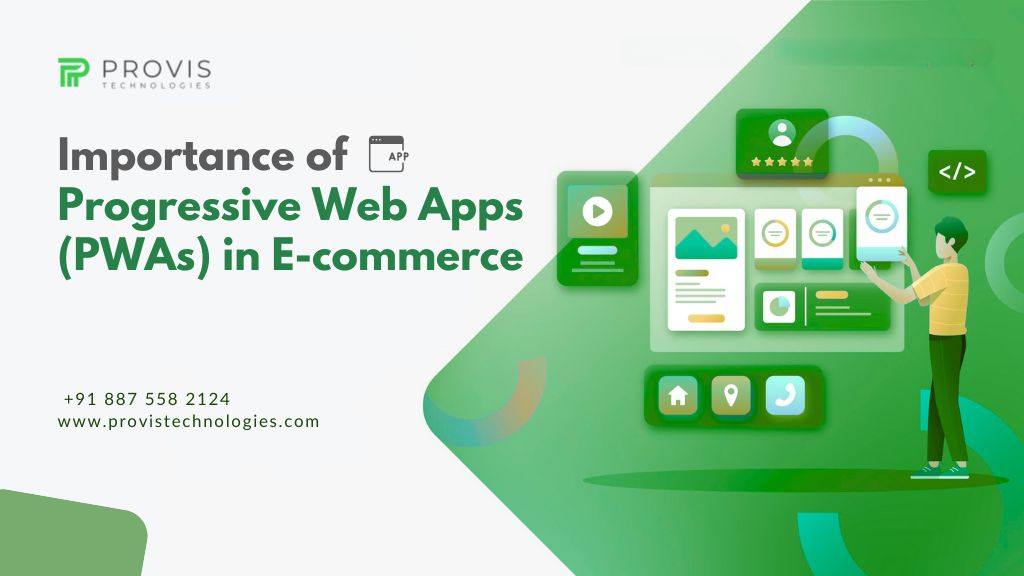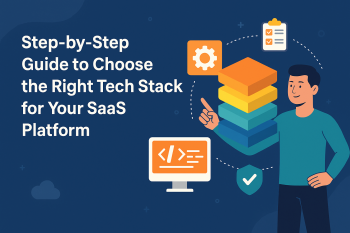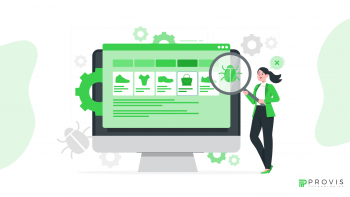Table of Contents
-
Introduction to PWAs
-
Understanding User Engagement in E-commerce
-
The Evolution of PWAs
-
Benefits of PWAs for E-commerce
-
Design & Development of PWAs for E-commerce
-
Challenges & Solutions in PWA Implementation
-
Bottom Line
-
FAQs
Introduction to PWAs
Progressive Web Apps are popularly known as PWAs and represent a modern approach to web development. They are a solid amalgam of the best features of traditional web applications with the capabilities of native mobile apps. Unlike traditional websites, PWAs offer a more app-like experience to users and provide features such as offline access, push notifications, and smooth navigation. At their core, PWAs are built using web technologies like HTML, CSS, and JavaScript, designed to deliver a fast, reliable, and engaging user experience across various devices & platforms. Today, PWAs seem perfect as an e-commerce mobile app alternative. Let’s explore PWAs for e-commerce.
Significance of PWAs in E-commerce
In e-commerce, where user engagement, user experience, and conversion rates are everything – PWAs can help meet these factors effortlessly. By combining the reach of the web with the performance of native apps, PWAs offer e-commerce businesses the opportunity to provide a compelling and immersive shopping experience to their customers. With features like offline access and push notifications, PWAs can drive higher user engagement, increase conversions, and ultimately boost revenue for online retailers. A PWA for e-commerce is one of the best ways to scale your business.
Understanding User Engagement in E-commerce
Importance of User Engagement for E-commerce Success
User engagement plays a crucial role in the success of e-commerce businesses. Engaged users are more likely to interact with the website, browse products, and make purchases – leading to higher conversion rates and increased revenue. In today’s competitive e-commerce space, businesses must prioritize user engagement to differentiate themselves and build customer loyalty.
Challenges Faced by Traditional E-commerce Platforms
Traditional e-commerce platforms often struggle to deliver the level of user engagement seen in native mobile apps. Slow loading times, bulky user interfaces, and limited functionality can detract from the overall shopping experience – leading to higher bounce & lower conversion rates. Additionally, the lack of offline access and push notifications further hinders user engagement on traditional e-commerce websites.
The Evolution of PWAs
Development & Adoption of PWAs
PWAs have gained traction in recent years as a solution to the limitations of traditional web and mobile applications. Spearheaded by Google and supported by other major tech companies, PWAs offer a compelling alternative for businesses looking to deliver better user experiences. With advancements in web technologies & browser capabilities, PWAs have become increasingly accessible.
Key Characteristics of PWAs
PWAs are characterized by several key features that set them apart from traditional web applications. These include:
Offline Functionality
PWAs can work offline or with limited connectivity, allowing users to access content and complete tasks offline.
Fast Loading Speed
PWAs load quickly and respond instantly to user interactions, providing a smooth and responsive experience.
Push Notifications
PWAs can send push notifications to users to keep them informed about updates, promotions, and other relevant information.
Add to Home Screen
Users can add PWAs to their device’s home screen, making them easily accessible, which increases engagement.
Responsive Design
PWAs are designed to work across various devices and screen sizes, ensuring a consistent experience for all users.
Benefits of PWAs for E-commerce
Enhanced User Experience
PWAs offer a superior user experience than traditional web applications, with features like offline access, push notifications, and fast loading times. By providing a more app-like experience, PWAs can increase user engagement & satisfaction, leading to higher conversion rates.
Improved Performance & Speed
PWAs are designed to deliver fast experiences to users, regardless of their device or network conditions. With features like pre-caching and service workers, PWAs can load quickly and respond instantly to user interactions, reducing bounce rates and increasing time spent on site.
Increased Conversion Rates
By offering an engaging shopping experience, PWAs can drive higher conversion rates for e-commerce businesses. Features like push notifications and add-to-home screen functionality encourage users to return to the site and complete their purchases, which helps in increased sales & revenue.
Offline Functionality
One of the primary advantages of PWAs is their ability to work offline or with limited connectivity. This means that users can continue browsing products, adding items to their cart, and completing transactions even when offline, improving accessibility and convenience.
Smooth Integration
PWAs can be integrated with existing e-commerce platforms and systems, making them easy to deploy and manage for businesses. Whether built from scratch or added as an extension to an existing website, PWAs offer a flexible and scalable solution for e-commerce businesses of all sizes.
Design & Development of PWAs for E-commerce
Planning & Strategy for PWA Implementation
The successful implementation of a PWA requires careful planning. Businesses must identify their goals, understand their target audience, and assess their technical capabilities before starting a PWA project. Moreover, budget, timeline, and resource allocation should be considered to ensure a successful outcome.
Tools & Technologies for PWA Development
PWAs can be developed using various tools & technologies, including popular frameworks like React, Angular, and Vue.js. Furthermore, several PWA-specific tools & libraries are available to developers, such as Google’s Workbox & Lighthouse. By leveraging these tools, developers can streamline the development process for PWAs to meet the necessary performance & usability standards.
User Interface (UI) & User Experience (UX) Design
The design of a PWA plays a crucial role in its success. UI & UX design principles should be applied to create a smooth and intuitive shopping experience. This includes responsive design, intuitive navigation, and clear calls to action. By prioritizing user experience design, businesses can ensure their PWAs deliver maximum value to users. You can connect with e-commerce development agencies like Provis Technologies for e-commerce PWA development.
Challenges & Solutions in PWA Implementation
Technical Challenges
PWA implementation can pose several technical challenges, such as optimizing performance, ensuring cross-browser compatibility, and managing data synchronization. However, these challenges can be addressed through careful planning, testing, and optimization.
Compatibility Issues
Ensuring compatibility across different browsers is another challenge in PWA implementation. While PWAs are designed to work across a wide range of platforms, browser capabilities, and device specifications can lead to inconsistencies in performance. To mitigate compatibility issues, developers should conduct thorough testing and implement fallback solutions where necessary.
Bottom Line
PWAs offer immense potential for enhancing user engagement and driving conversion rates in e-commerce. Despite technical challenges & compatibility concerns, implementing PWAs can revolutionize the online shopping experience. By prioritizing performance optimization, businesses can overcome obstacles and unlock the full benefits of PWAs. With their ability to deliver fast, reliable, and engaging experiences across devices, PWAs represent the future of e-commerce. Embracing this innovative technology can help businesses stay ahead of the curve and provide users with smooth and satisfying shopping experiences.
FAQs
What are PWAs?
PWAs are web applications that utilize modern web technologies to offer a native app-like experience to users across various devices & platforms.
How do PWAs benefit e-commerce businesses?
PWAs enhance user engagement and drive conversion rates by providing a fast, reliable, and engaging shopping experience across devices.
What are some key features of PWAs?
Primary features of PWAs include offline functionality, fast loading speed, push notifications, add-to-home screen, and responsive design.
How are PWAs developed for e-commerce?
PWAs for e-commerce are developed through careful planning, strategic implementation, and utilizing tools & technologies like React, Angular, or Vue.js. Contacting e-commerce development agencies like Provis Technologies can also help.
What challenges do businesses face when implementing PWAs?
Challenges include technical hurdles like performance optimization, cross-browser compatibility, security concerns, and integration with existing systems.
What are some success stories of PWAs in e-commerce?
E-commerce giants like Alibaba and Flipkart have successfully implemented PWAs – resulting in higher user engagement & conversion rates.
Written By
Author's Picks
- Provis Technologies Is All Set to Thrive by Creating Solutions for With a 360-Degree Marketing Approach: GoodFirms
- 04/11/2022
- Laravel + AngularJS A super Combo For Modern Web Development
- 14/01/2019
- Key Features of Laravel
- 07/10/2019
Categories
- AI for Startups
- AI in Web Development
- AI Integration
- AI Platforms
- AI Prompt
- AI Tools
- AI Trading Software
- Android App
- Android vs iOS Development
- Angular
- API
- API Development
- App
- app development
- App Idea
- App User Feedback
- Application
- Artificial Intelligence
- Audit Services
- Automotive Industry
- Awards and Recognition
- Business Consulting
- Business Website
- Chatbots
- CRM
- CRM for Financial Advisors
- Custom CRM
- Custom SaaS
- Custom Website
- Customer Service
- dashboard design
- Developing a Mobile App
- Digital Business
- E-commerce
- EMR Integration
- Finance
- Financial Advisors
- Financial Advisors
- GIT
- Health Insurance
- iOS App
- iOS App Development
- IoT Mobile App Development
- IoT Platforms
- IT Audit Services
- IT Consulting
- IT Strategies
- Java Development
- Laravel
- Lean Canvas
- Learning Management System
- Logistics Apps
- Mobile App Development
- MVP
- Native App
- News Aggregator Site
- OTT
- Outsourcing IT
- Payment Gateway
- predictive analysis
- Product Launch Strategy
- Progressive Web App (PWA)
- Prototype
- Recommender Systems
- Ruby
- SaaS
- SaaS Application
- SaaS Business
- SaaS Company
- SaaS Development
- SaaS Product
- SaaS Project
- Sales Funnel
- SEO
- Shopping Cart
- Software Development
- SSL and TLS
- Startup Checklist
- Technology
- Tetradic Color Scheme
- UI/UX Design Company
- Unit Testing
- User Flow
- User Testing
- Web Development
- Web Performance Optimization
- website Maintenance Services
- Website Migration Service
- Website Speed Optimization
- WooCommerce
- WordPress





